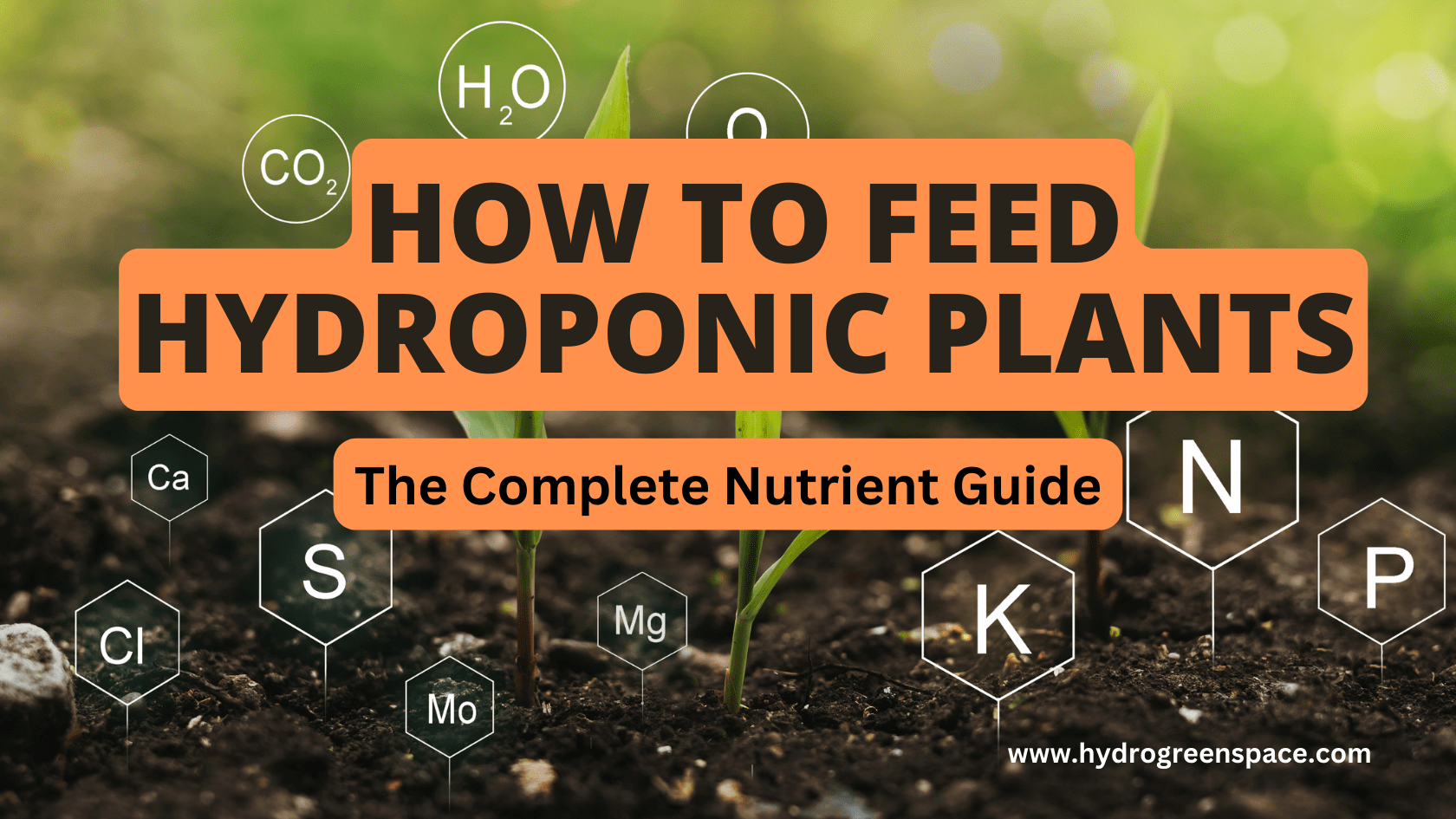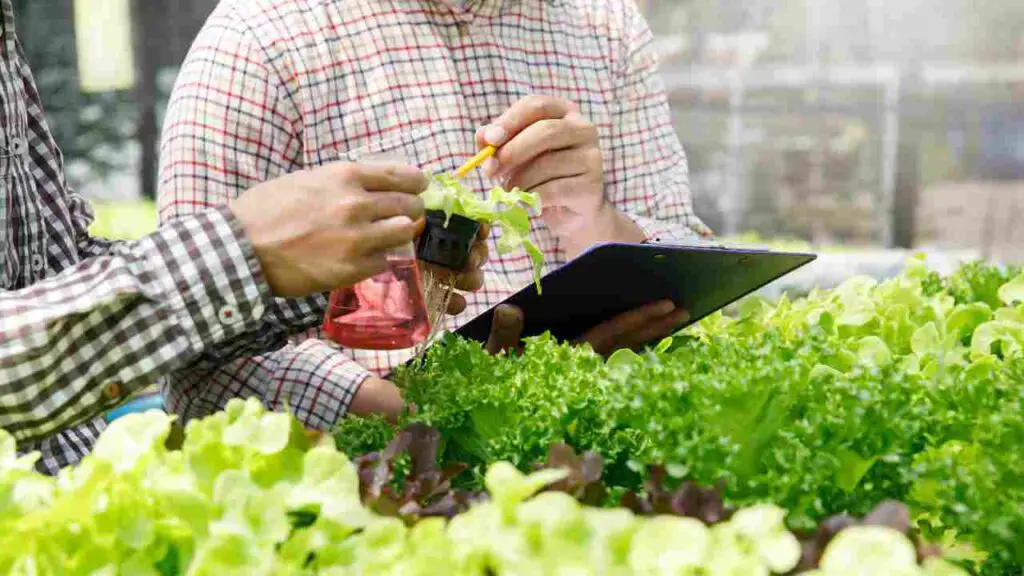How to Feed Hydroponic Plants: The Complete Nutrient Guide

When I first started my hydroponic garden, I was thrilled to grow plants without soil. I eagerly set up my hydroponic system and added seeds and seedlings. At first, the tiny sprouts looked happy and healthy. But within weeks, I noticed issues.
Some leaves turned pale yellow and got brown spots. My tomato seedlings stayed stubby and small. Clearly, something was wrong, but what? I provided plenty of water and sunlight. So why weren’t my hydroponic plants thriving?
It took me longer than I’d like to admit to realize one critical oversight – nutrition! Just like people, plants need proper food to grow strong. In hydroponics, there’s no soil for roots to draw nutrients from. I had to provide complete plant nutrition through the water.
Once I learned about key nutrients like nitrogen, phosphorus, and potassium that plants need to flourish, I had an “aha moment”! Proper plant food was the missing link in my hydroponic system. No wonder my plants were struggling without their “balanced diet”.
While frustrating at first, I’m glad I learned this essential lesson. Giving your hydroponic plants the right nutrients is vital for them to thrive. With time, patience, and following best practices which I’ll share here, you can master this too!

Table of Contents
Why Nutrition is Key in Hydroponics
Hydroponics is a method of growing plants without soil. Instead, the plant’s roots are suspended in a nutrient-rich water solution. There are a few key things to understand about hydroponics:
- Plants are grown in containers like buckets or pipes, not ground soil.
- The nutrient solution delivers food and water directly to the roots.
- Special hydroponic systems pump and re-circulate the solution.
This means there is no soil for plants to draw minerals from. That’s why getting the right nutrition is absolutely crucial in hydroponics:
- Plants need the right amounts of nutrients to grow properly. Too much or too little will cause issues.
- The main nutrients plants need are nitrogen, phosphorus, and potassium (NPK).
- Plants also need other micronutrients in smaller amounts like calcium, magnesium, and iron.
- You have to carefully mix the right formula and maintain it in the hydroponic system.
- Nutrient levels and pH need regular monitoring and adjustment.
- Without proper hydroponic nutrition, plants will be stressed and have problems.
So while soil gardening relies on nutrient-rich soil, in hydroponics the nutrients have to be manually provided and balanced. By getting the “recipe” right, your hydroponically grown plants can thrive!
Diving Deeper into Hydroponic Nutrients
Earlier we discussed the three main macronutrients plants need: nitrogen (N), phosphorus (P), and potassium (K). Let’s explore these and other nutrients further:
Main Macronutrients
- Nitrogen (N) – Supports healthy green growth and plant proteins. Deficiency causes yellowing leaves.
- Phosphorus (P) – Important for root, flower, and fruit development. Boosts buds and blooms.
- Potassium (K) – Crucial for overall plant health. Helps regulate water uptake.
Important Micronutrients
- Calcium – Strengthens cell walls. Prevents blossom end rot in tomatoes.
- Magnesium – Key for chlorophyll production and photosynthesis. Keeps leaves green.
- Iron – Facilitates energy production. Prevents yellowing between leaf veins.
- Manganese – Involved in nutrient breakdown and absorption. Needed for new growth.
- Zinc – Plays a role in enzyme and hormone function. Deficiency stunts plants.
Getting the balance right is key
- Too much of any nutrient can “burn” plants or cause toxicity.
- Deficiencies create obvious symptoms like discolored or twisted leaves.
- Ensure a balanced blend of macro and micronutrients suited for each growth phase.
- Adjust levels based on plant signals to prevent excesses or deficiencies.
With the ideal nutrient balance, your hydroponic plants will thrive from seed to harvest!
Choosing the Right Hydroponic Nutrients
When starting hydroponics, one key decision is whether to use organic or synthetic nutrient solutions. Here’s an overview of the pros and cons of each:
Organic Nutrients
Pros:
- Derived from natural sources like fish emulsion, kelp, and compost teas
- Enhance soil microbial life
- Leave no chemical residue
Cons:
- More expensive
- Spoil faster than synthetic nutrients
- Require more frequent application
Examples: General Organics, Earth Juice, Dr. Earth
Synthetic Nutrients
Pros:
- Concentrated formulas are more affordable
- Extended shelf life compared to organic
- Customizable blends with precise NPK ratios
Cons:
- Made from chemical salts
- Must be used carefully to avoid buildup
- Not permitted in certified organic gardening
Examples: General Hydroponics Flora Series, Advanced Nutrients, Botanicare
When first starting out, a reputable all-in-one synthetic blend is usually the simplest option. As you gain experience, you may wish to explore making your own custom organic or synthetic nutrient solutions.
The key is choosing a complete, balanced product suited to your plants’ needs and your hydroponic system.
Step-by-Step Guide to Feeding Your Hydroponic Plants
Once you have your nutrients, it’s time to master the process of properly feeding your hydroponic system. Follow this step-by-step guide:
Carefully Mix Nutrients
- Start with a reputable brand of synthetic or organic hydroponic nutrients.
- Check the label for mixing instructions specific to the product.
- Measure out the required amounts of each nutrient part (A, B, micros, etc).
- Mix the products together in your reservoir, using warm water to dissolve.
- Double check EC/TDS and pH levels match target ranges.
Transfer Nutrient Solution to Reservoir
- Run solution through tubing and components to flush before adding plants.
- Make sure all pumps are working to circulate the nutrients.
- Place plants into the system containers and fill the reservoir.
Maintain Proper Conditions
- Use an EC meter to track electrical conductivity/mineral levels.
- Monitor pH regularly with a pH meter, keeping within 5.5-6.5 range.
- Top off the reservoir with plain or pH-adjusted water as needed.
- Completely replace nutrients every 1-2 weeks.
Adjust Based on Plant Needs
- If leaves are yellow, increase EC/nutrients.
- If tips burn, decrease EC levels.
- Leach systems periodically to prevent salt buildup.
- Supplement key nutrients if deficiencies appear.
- Reduce strength for seedlings and young plants.
Common Feeding Mistakes and How to Avoid Them
When I was starting out, I made some classic hydroponic plant feeding mistakes. Here are some common issues and how to avoid them:
Overfeeding
- What does it look like? Leaf tips and margins turn brown or yellow, roots show damage
- How I fixed it: Reduced overall nutrient levels and flushed the system to remove excess
Underfeeding
- What does it look like? Slow and stunted growth, leaves yellowing or dropping
- How I fixed it: Slowly increased nutrient concentration until plants improved
pH Fluctuations
- What does it look like? Nutrient deficiencies even at proper levels
- How I fixed it: Monitored and adjusted pH regularly to maintain the 5.5-6.5 range.
The key is close observation and quick correction.
Some tips
- Start nutrients lower than recommended, increasing slowly.
- Check pH and EC/TDS levels frequently to catch issues early.
- Flush systems to correct excesses and clear out salt buildup.
- Leach soilless media regularly to avoid nutrient accumulation.
With vigilant monitoring and readiness to adjust, you can avoid common hydroponic feeding pitfalls. Let your plants guide you to the right balance!
FAQs on Nourishing Hydroponic Gardens
If you’re new to hydroponic nutrition, there are probably some lingering questions. Here are answers to some frequently asked questions:
- Q: How often should nutrient solutions be replaced?
- A: Every 1-2 weeks, more often for faster-growing plants.
- Q: Can I use compost tea instead of commercial nutrients?
- A: Compost tea doesn’t provide all the nutrients plants need, but can supplement.
- Q: Is tap water ok for the reservoir?
- A: Tap water must be left out to dechlorinate, but may raise pH and EC levels.
- Q: Why do leaf tips burn even though I follow mixing directions?
- A: This often occurs from accumulated salts. Try flushing the system.
- Q: How can I provide micronutrients lacking in my base nutrients?
- A: Add a micronutrient supplement or foliar spray targeted to the specific need.
- Q: Is there a general rule for EC/PPM levels?
- A: 500-800 PPM is a common target, increasing with plant maturity.
- Q: How much pH fluctuation is acceptable?
- A: Fluctuate no more than 0.2-0.3 up or down to maintain nutrient availability.
Have more questions? Don’t hesitate to ask in the comments section! Proper hydroponic plant nutrition takes some trial and error but you’ll get the hang of it.
If I could go back and tell my past hydroponic gardening self one thing, it would be – “Don’t overlook your plants’ nutrients!”
Proper hydroponic nutrition is truly the key to robust, vibrant plants and satisfying yields. While it takes effort to master, the results are so rewarding.
Approach plant feeding with patience, adjust based on observation, and learn from any missteps. Over time, you’ll get a feel for perfectly nourishing your custom hydroponic environment.
I hope these tips help you gain the knowledge and confidence to feed your hydroponic garden successfully. Understand the essential nutrients, follow the mixing steps, stick to targets – and watch your plants thrive beautifully!

